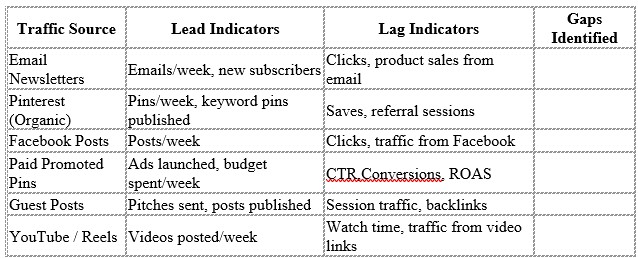
The Traffic Stream Strategy
(H1) Treat Each Traffic Source as Its Own Revenue Stream
Imagine your blog traffic sources—email newsletters, Pinterest, SEO, Instagram, Facebook, paid ads—as individual mini-businesses. Each one deserves a tailored marketing plan. That’s how you reveal weak spots and build momentum from every angle.
(H2) Why This Matters
If you lump all traffic together, you’ll overlook where growth slows or stops. By separating them, you uncover strengths and holes. A strong newsletter strategy may not make up for stale SEO. You’ll feel empowered to focus on channels you can control—like your email cadence—rather than relying on unpredictable paid boosts.
(H2) Common Traffic Sources + Possible Hidden Gems
Here’s a breakdown of key channels—and sources you mightn’t have thought of:
Organic Channels:
Email Newsletters – predictable ownable flow
Pinterest – SEO + visuals for evergreen pull
SEO / Google Search – long-term ranking
Instagram / Facebook / TikTok – community + link sharing
Guest Posts or Collaborations – lighthouse backlinks
Podcast Appearances – tap into new audiences
YouTube or Reels – visual recipes
Community Forums (Reddit, Facebook Groups) – niche engagement
Press or Media Mentions – credibility + referral traffic
Paid Channels:
Boosted Social Posts (e.g. Facebook/Instagram)
Pinterest Promoted Pins
Search Engine Ads (e.g. Google AdWords)
Sponsored Content (on other blogs or media)
Each deserves its own strategy.
Lead vs. Lag Indicators
To treat each channel like a mini-business, track two types of metrics:
Lead Indicators predict success by showing proactive activity you can control:
Emails sent per week
Pins created and scheduled
Keywords optimized on old posts
Number of stories or IG reels posted
Ads launched
New backlinks acquired
Lag Indicators show the result of your efforts:
Website traffic or sessions
Click-through rate (CTR) from social or emails
Conversion rate to your newsletter or product
Boosted pin saves
Income from affiliate or product sales tied to that channel
Lead indicators are your control knobs. Lag indicators are the dashboard showing outcomes. Track both to see which channels are working and which channel tactics need a boost.
Marketing Plan Table Exercise
Create a table such as the one below to identify the gaps in your marketing strategy at a glance.

Don’t get caught in the over-tracking trap. You don’t have to do everything and you don’t have to track everything, but you do have to track what matters. Decide what matters, do it and track it!
As you imagine filling out this table, which channel instantly shows a gap that needs creative focus?
Want help applying this exercise to your blog? Let’s talk.
Time to Get Creative
You might see missing cells. Here's how to fill them:
If email send volume is low → schedule it as a recurring weekly block
If Pinterest pins are outdated → create seasonal content + fresh keywords
If Facebook traffic lags → try a collaboration or giveaway to revive interest
If paid ads underperform → split-test creatives or tweak your targeting
If guest post slots are empty → pitch a new site or repurpose your top post
Lead indicators tell you what to do. Lag indicators tell you if it worked. When you own the lead actions, the lag results follow.
Focus on What You Control
Organic and owned channels (email, pin creation, consistent posting) are under your control. When algorithm changes or ad spend fluctuates, these are your foundation. Take charge of lead tasks—in your calendar—and watch the compounding effect.
Your Monthly Channel Check-In
Create a monthly review ritual:
Fill in your table – track lead and lag for each source.
Identify 1 channel to prioritize – the one with the biggest gap.
Craft a mini action plan – e.g. “Schedule 3 new pins/week,” “Pitch 5 guest posts.”
Execute & track next month.
Over time, all streams get stronger. You’ll move from hoping for traffic to building consistent systems.
Final Mindset Shift
You are a traffic strategist. Each channel is a lever. As lead indicators grow, lag indicators shoot up—and so does your confidence. That makes you feel like the CEO, not just the cook in the kitchen.
Ready for personalized clarity? Book a free discovery call and start your recipe for success.
Mini FAQ
Q: What’s a good lead indicator for SEO?
Track the number of pages optimized or keywords updated each month.
Q: Can I combine lead/lag metrics into one dashboard?
Absolutely. Use a simple spreadsheet with monthly columns per traffic source.
Q: How long before lag indicators reflect effort?
Organic channels typically show results in 6–12 weeks. Paid channels can move faster—often 1–2 weeks.
